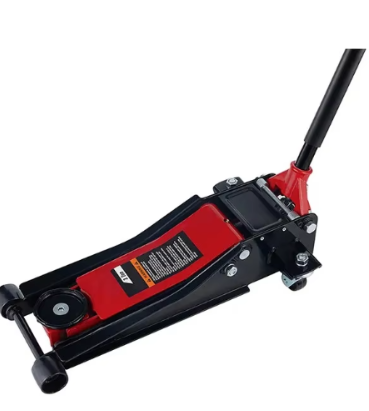4-Post Car Lifts: Stability and Storage Solutions
Advantages of 4-Post Lifts
Four post car lifts give great stability because of their solid build, which helps spread the weight of vehicles evenly at all four contact points. They work really well for storing cars over extended periods, giving rest assured to car collectors and garage owners alike. The bigger platform space means these lifts can take on bigger rides too, from SUVs right down to pickup trucks, so they're popular among workshops that deal with different types of vehicles day in day out. Plus, how these four post lifts are built makes getting into vehicles much easier, something mechanics appreciate when working on several jobs at once without having to struggle with awkward angles or limited reach.
Limitations of 4-Post Lifts
4 post lifts definitely have some downsides even though they offer many benefits. The price tag tends to be higher compared to standard 2 post models, something that can really strain budgets for small repair shops or hobbyists working on cars in their garages. Another issue comes down to space requirements since these lifts take up quite a bit of room. That means fewer units can fit into already crowded workshop areas. What makes them tricky for some mechanics too is getting proper access underneath vehicles during complex repairs. Working around the limited clearance becomes frustrating when dealing with intricate underbody components that need thorough inspection and servicing.
2-Post Car Lifts: Flexibility and Configuration Choices
Symmetric Lifts: Balanced Weight Distribution
The symmetric design of 2-post lifts spreads weight evenly throughout the structure, making these lifts safer and more stable when raising or lowering cars. Most other lift designs don't handle weight so well, often putting too much pressure on one spot which can be dangerous over time. That's why mechanics trust symmetric lifts for daily work. Installation isn't complicated either, and they take up significantly less floor space compared to those big four-post models. For small shops where every square foot counts, this matters a lot. Many technicians actually favor these lifts for routine maintenance jobs because they give good access underneath the car. Getting at brake lines, suspension components, or exhaust systems becomes much easier without having to maneuver around bulky equipment.
Asymmetric Lifts: Improved Door Access
The main benefit of asymmetric lifts comes down to positioning cars further back which makes getting in and out through doors much easier. This really matters in busy repair shops where technicians need constant access to different parts of the vehicle throughout their workday. Another key feature worth mentioning is how these lifts stop cars from moving around during service, which adds serious safety benefits especially when dealing with heavy trucks or specialty vehicles that don't fit standard lift configurations. When deciding between symmetric and asymmetric models, most shops find it boils down to what kinds of vehicles they typically service plus day to day workflow requirements. Getting this right can make all the difference in streamlining operations at automotive repair facilities.
Key Drawbacks of 2-Post Designs
Two post car lifts definitely come with some downsides even though they work well for many situations. The main problem comes when dealing with heavy vehicles. Most cant handle large trucks or SUVs properly unlike four post lifts that were built for this kind of workload. People who try to lift heavier cars on two posts usually run into trouble because the weight limit just isn't there. That means these lifts tend to work best for lighter stuff like regular sedans and maybe small pickup trucks at most. Installation also poses problems since they require solid anchoring into concrete floors. Getting this done right often means hiring professionals and spending extra money on setup. On the plus side, getting underneath the vehicle is generally easier with two post designs. Still不少 mechanics report feeling less confident about stability during certain tasks compared to working with those sturdier four post units. Anyone shopping for a lift should really think through all these points before making a decision based solely on price or initial convenience.
Scissor and Mid-Rise Lifts: Space-Saving Alternatives
Scissor Lifts: Pros and Cons
Scissor lifts get a lot of praise because they take up so little room, which makes them ideal for small garages. When not needed, these lifts just fold right down flat against the floor. This keeps things neat in the shop and makes it easier to move around or rearrange equipment as needed. The platform on scissor lifts stays steady during work, which matters a lot when doing精细的汽车维修工作 or needing to reach underneath the car. But there's one catch worth mentioning. Scissor lifts don't go as high as those 2-post or 4-post models out there. For bigger trucks or SUVs that sit higher off the ground, this can be a real problem. So even though they save space, mechanics working with taller vehicles might find themselves stuck with scissor lifts that just won't do the job properly.
Mid-Rise Lifts: Compact Versatility
Mid rise lifts combine portability with decent lifting power, which explains why so many mechanics and weekend warriors grab one when possible. These units take up less floor space than full sized lifts but still let technicians get underneath most vehicles comfortably. Garage owners love this because it means they can squeeze another workstation into their shop without losing out on proper maintenance capabilities. Most models handle everything from regular family sedans right up through small pickup trucks too. That kind of flexibility really matters in busy auto shops where different makes and models come rolling through daily for oil changes, brake jobs, or whatever else needs fixing.
Key Factors for Choosing the Right Car Lift
Garage Space and Ceiling Height Requirements
Before picking out a car lift, take a good look at how much room there actually is in the garage plus what the ceiling height looks like. Various kinds of car lifts have different needs when it comes to headroom and floor area, so they might not all work well in every garage setup. Take 2 post lifts for example they usually take up less ground space but still want plenty of clearance above them to operate safely. Then again, those four post models tend to be quite tall themselves, so getting precise measurements of the garage becomes really important just to make sure everything fits properly without running into problems during installation later on.
Vehicle Weight and Lifting Capacity
Knowing how much weight the cars we intend to work on actually carry matters a lot when picking out a car lift. Different lifts come with their own weight restrictions, so going for something that can't handle what needs lifting might end up creating real problems down the road. Safety first folks, always check that whatever lift gets installed can actually support the full weight of whatever vehicle sits on top of it. Looking at what the manufacturers say about their products isn't just helpful for finding the right gear, it's basically required if anyone wants to avoid headaches later on.
Safety Features and Maintenance Needs
When it comes to car lifts, safety features shouldn't just be an afterthought but something we look for first. Automatic locks, those emergency stop mechanisms, and solid build quality really matter when working under vehicles. Don't forget about regular checkups too. Most shops schedule monthly inspections to keep everything running smoothly while staying within OSHA guidelines. Speaking from experience, lifts designed with maintenance in mind last much longer. The ones where parts are accessible without dismantling half the machine make life so much easier in the long run. A good quality lift becomes part of the workshop family over time, provided it gets proper care and attention.
FAQ
What are the main advantages of 4-post car lifts?
4-post car lifts offer exceptional stability and are ideal for long-term vehicle storage. They can accommodate larger vehicles such as SUVs and trucks, and they provide easy access for mechanics.
How do 2-post lifts differ from 4-post lifts?
2-post lifts require less space and are better for accessing the vehicle's undercarriage, which is suitable for regular maintenance. However, they offer less support for heavier vehicles compared to 4-post lifts.
Are scissor lifts suitable for all vehicle types?
Scissor lifts are compact and ideal for limited spaces, but their lifting height limitation makes them less suitable for larger vehicles.
What should be considered when choosing a car lift?
Consider garage space, ceiling height, vehicle weight, lifting capacity, and the safety features of the lift. Ensuring compliance with these factors will help in choosing the right lift for your needs.

